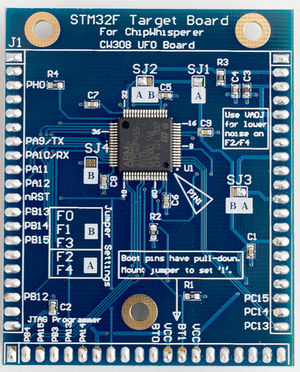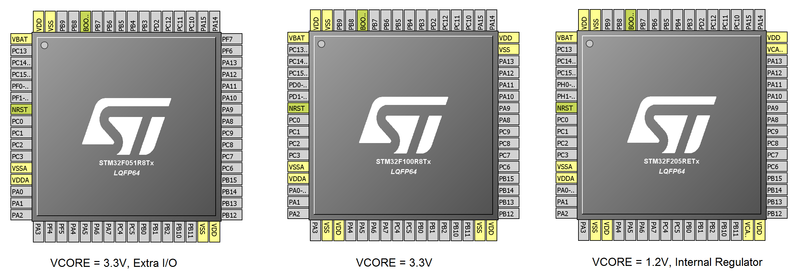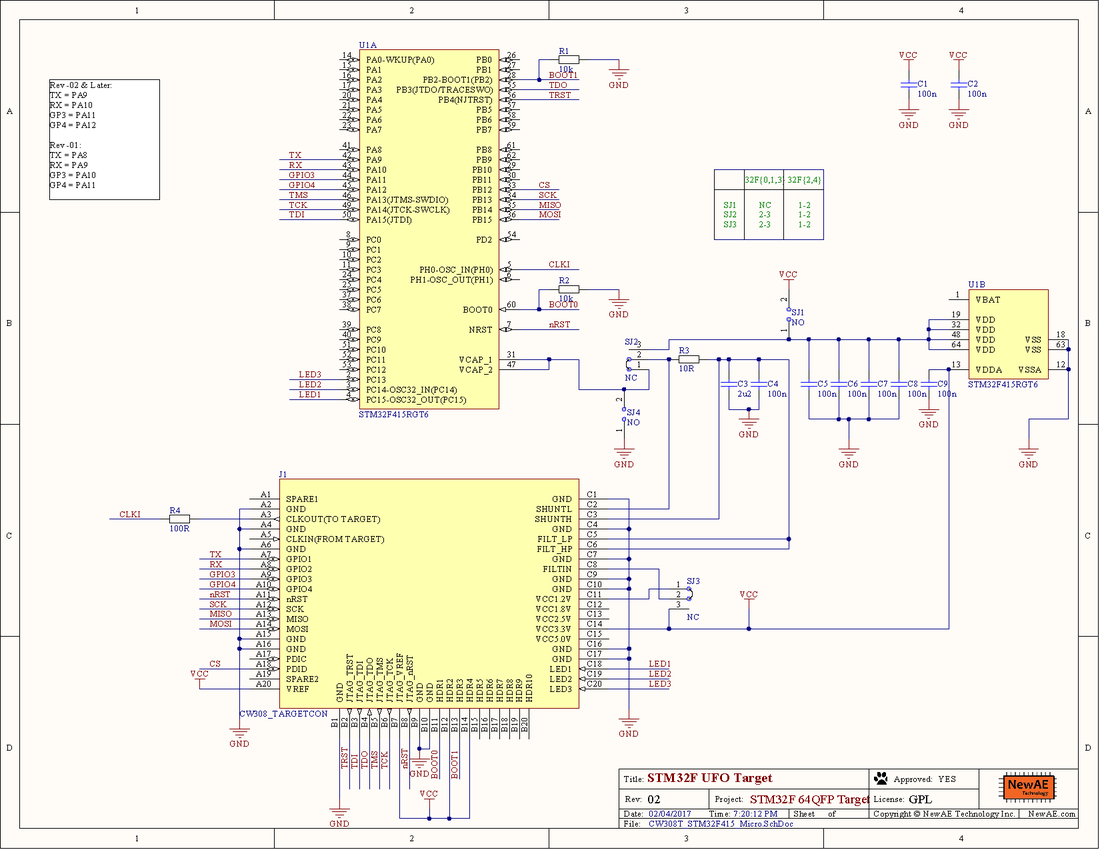| As of August 2020 the site you are on (wiki.newae.com) is deprecated, and content is now at rtfm.newae.com. |
Difference between revisions of "CW308T-STM32F"
(→Example Projects) |
(→Example Projects) |
||
| Line 110: | Line 110: | ||
== Example Projects == | == Example Projects == | ||
| − | SimpleSerial builds for each of the STM32Fx Devices. Each device is a separate HAL | + | SimpleSerial builds for each of the STM32Fx Devices. Each device is a separate HAL. These HAL modules have been copied from ST's HAL (not the CUBE) and greatly reduced in size by deleting unused files (such as headers for unused devices), and combining several C-source files into a single low-level C-file. |
=== Building ST Example on Command Line === | === Building ST Example on Command Line === | ||
| + | The regular firmware build process works with the STM32 devices. For example, to build `simpleserial-aes`, navigate to the folder `chipwhisperer\hardware\victims\firmware\simpleserial-aes` and run the following command on the command line: | ||
| + | <code> | ||
| + | make PLATFORM=CW308_STM32F0 CRYPTO_TARGET=TINYAES128C | ||
| + | </code> | ||
| + | |||
| + | If all goes well, this command will finish by printing the output file size and the platform: | ||
| + | [[File:Stm32-make.png]] | ||
=== Building ST Example via GUI === | === Building ST Example via GUI === | ||
Revision as of 07:14, 25 April 2017
| CW308T-STM32F | |
|---|---|
 | |
| Target Device | ST STM32F |
| Target Architecture | Cortex M0,M3,M4 |
| Hardware Crypto | Possible |
| Design Files | OSH Park PCBs |
| Supported Apps | Simple Serial Enc/Auth |
| Programmer | ST-LINK/V2 |
| Status | Released |
Contents
Supported Devices
The STM32F board supports several STM32F devices in the TQFP-64 package. Various solder jumpers need to bet set to either the "A" or "B" position to select appropriate VCC supply for the different series. The following table summarizes examples of suitable devices:
| STM32F Series | Package | Device | Hardware AES | Tested | Jumper |
|---|---|---|---|---|---|
| F0 | TQFP-64 | STM32F071RBT6 | No | B | |
| F1 | TQFP-64 | STM32F100RBT6B | No | B | |
| F2 | TQFP-64 | STM32F215RET6 | Yes | Yes | A |
| F3 | TQFP-64 | STM32F303R8T6 | Yes | No | B |
| F4 | TQFP-64 | STM32F415RGT6 | Yes | Yes | A |
| F4 | TQFP-64 | STM32F405RGT6 | No | Yes | A |
VCC-Int Supply
Several devices (F2, F4) have internal core voltage regulators. By default the CW308 board attempts to provide power for these pins, but the voltage may not be high enough to cause the internal regulator to disable itself. In this case you can use the VADJ regulator to ensure the internal regulator is disabled. See Targets with Internal Regulators for details.
Pin-outs across TQFP Devices
The following shows differences in pinouts between three groups of devices. The left-most is the STM32F051RB, which uses the same 3.3V VCORE as the STM32F1/F3. It has fewer VCC pins, so the I/O occupying that are VCC/GND pins on the STM32F1 (such as PF6/PF7) are tied to GND/VCC. The right-most part is the pinout of the STM32F2/F4. It has an internal regulator, where the VCAP pins are the output of this regulator (and input to the internal core logic).
Note for the devices with a 3.3V VCORE, you should not mount decoupling capacitors C5/C6/C7/C8. You will still get some leakage with those capacitors mounted, but a stronger signal is present without them.
Hardware AES
The STM32F21x, and STM32F41x/43x have hardware crypto modules (AES, DES, TDES) along with hardware hash (SHA1, MD5).
Programming Connection
The 20-pin JTAG port (J6 on CW308 Board) can be used with the ST-LINK/V2 which is a low-cost JTAG programmer.
It is also possible to use other JTAG programmers such as OpenOCD. The following command worked with an Olimex OpenOCD programmer and their OpenOCD for Windows software:
openocd -f path/to/board/files/cw308.cfg -c init -c targets -c "halt" -c "flash write_image erase path/to/firmware.hex" -c "verify_image path/to/firmware.hex" -c "reset run" -c shutdown
where the contents of cw308.cfg are
source [find interface/olimex-arm-usb-ocd-h.cfg] source [find target/stm32f4x.cfg] reset_config srst_only
Example Projects
SimpleSerial builds for each of the STM32Fx Devices. Each device is a separate HAL. These HAL modules have been copied from ST's HAL (not the CUBE) and greatly reduced in size by deleting unused files (such as headers for unused devices), and combining several C-source files into a single low-level C-file.
Building ST Example on Command Line
The regular firmware build process works with the STM32 devices. For example, to build `simpleserial-aes`, navigate to the folder `chipwhisperer\hardware\victims\firmware\simpleserial-aes` and run the following command on the command line:
make PLATFORM=CW308_STM32F0 CRYPTO_TARGET=TINYAES128C
If all goes well, this command will finish by printing the output file size and the platform:


